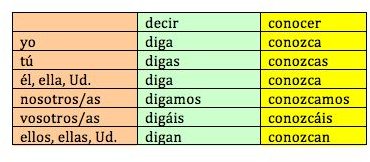Learning Spanish: How to Form and Use the Spanish Subjunctive Mood
The Spanish Subjunctive
In Spanish we could say, “Tú eres buen tutor.” (You are a good tutor.) As in English, we would make that subjunctive by saying “Es importante que tú seas buen tutor.” (It is important that you be a good Tutor.) We used the Spanish verb “ser” in its present subjunctive because it relates an attitude on the part of the speaker. To see how the subjunctive verb is formed, read on…
How the Spanish present subjunctive is formed
The presen
t subjunctive in Spanish has its special set of endings as indicated on the chart on the left. Notice that the endings are mostly “reversed” from their present tense indicative endings.
We add these endings to the “verb stem” in the yo (first person singular) form. The “verb stem” in Spanish is what we have left when we remove the verb ending. So with the verb hablar, the verb stem in the yo form (hablo) would be habl-. So we just refer to the chart and add the appropriate ending. Since hablar is in the -ar family, we add the first column endings.
Let’s compose a sentence using hablar in the subjunctive:
Es important que tú hables bien. It’s important that you speak well.
Spanish irregular “yo” verb forms
Many Spanish verbs have irregular forms in their yo (present tense, first person singular) form. Here’s where knowing how to conjugate Spanish verbs helps. For example, we have digo (from decir) and conozco (from conocer). For the Spanish present subjunctive, just add the appropriate endings to the irregular yo form and maintain the pattern throughout.

A few Spanish verbs are irregular through the present subjunctive.
Several commonly used Spanish verbs are irregular throughout the present subjunctive and do not follow the foregoing rules. Those verbs are conjugated in the chart below:

Spanish uses the subjunctive more extensively than English.
In Spanish the subjunctive is used:
♦ After impersonal expressions
Es necesario que compress el boleto hoy. It is necessary that you buy the ticket today.
The following expressions always trigger the subjunctive:
Es bueno - It is good.
Es importante - It is important.
Es imposible - It is impossible.
Es malo - It is bad.
Es mejor - It is better.
Es Necesario - It is necessary.
Es una lástima - It is a shame.
Es urgente - It is urgent.
♦ With verbs of “will and influence”
Yo quiero que tú digas al medico. - I want you to speak to the doctor.
With verbs of “emotion.”
Me gusta que tengas una actitud positiva. - I’m glad you have a positive attitude.
♦ With verbs of “doubt or denial.”
No creo que Mauricio quiera ir al medico. I don’t believe Mauircio wishes to go to the doctor
♦ In subordinate adjective clauses where the antecedent is not certain
Necesito un libro que tenga artículos sobre nutrición. I need a book that has articles on nutrition.
♦ Following adverbial clauses
Hay unas vendas en el botoquín en caso de que las necesites. There are some bandages in the first-aid kit in case you need them.
Note: The following Spanish conjunctions always require the subjunctive:
a menos que - unless
antes (de) que - before
en caso (de) que - in case
para que - so that
sin que - without, unless
Learn more about the Spanish subjunctive
For even more information on the Spanish subjunctive mood, visit these web sites:
Study Spanish.com - The Subjunctive
Take an online quiz on the Spanish subjunctives at About.Spanish.com
This post is part of the series: Learning Spanish: The Subjunctive Mood
Spanish verbs come in two moods: the indicative (stating the real) and the subjunctive (stating the hypothetical or wishes). This series is all about the subjunctive, which Spanish uses much more extensively than English.
